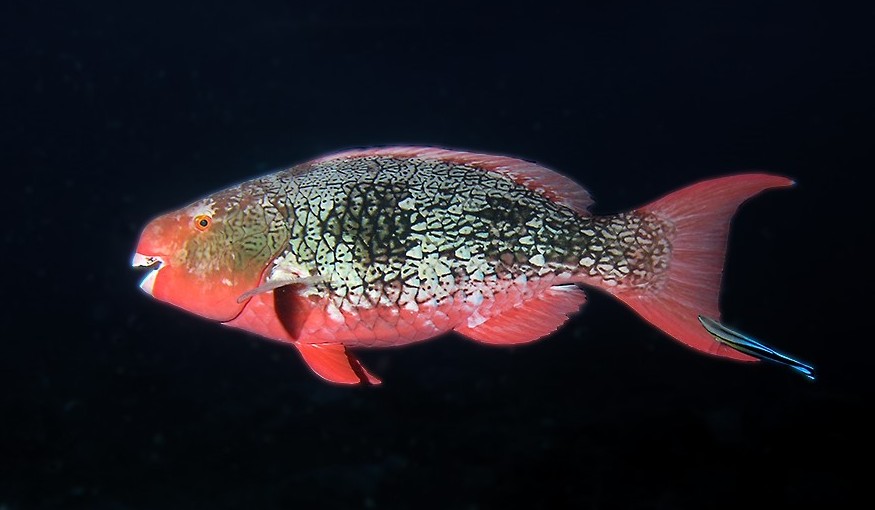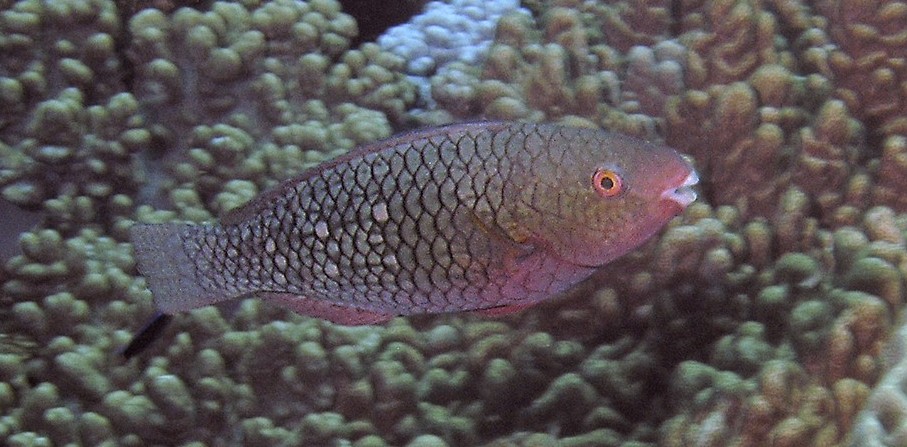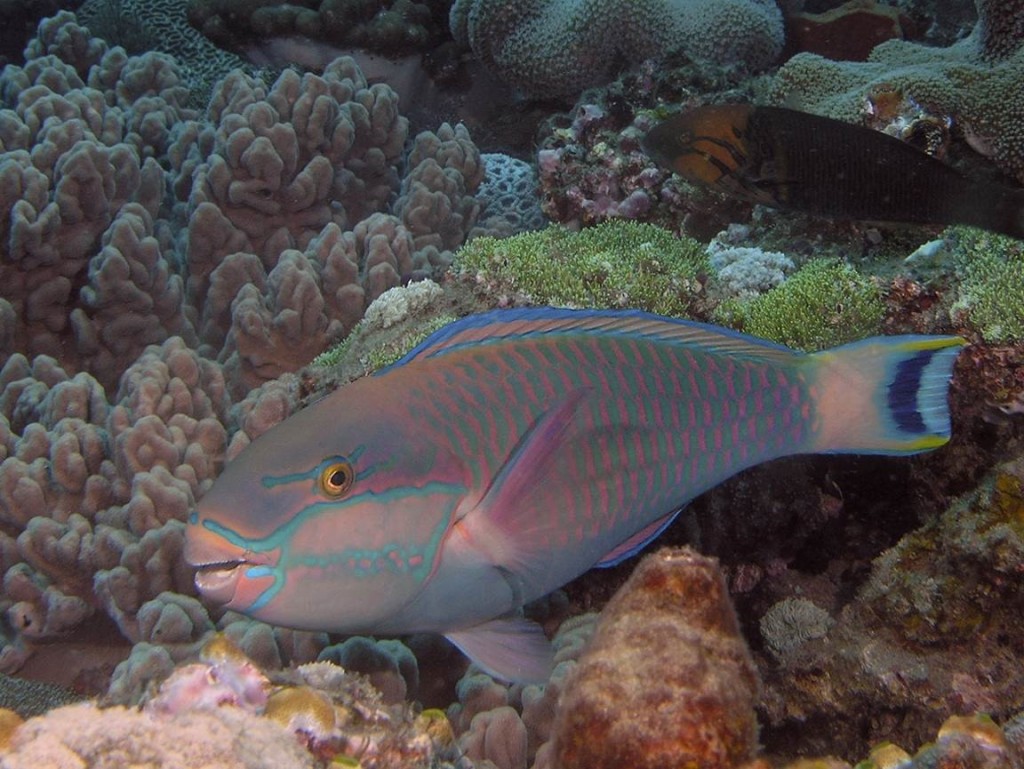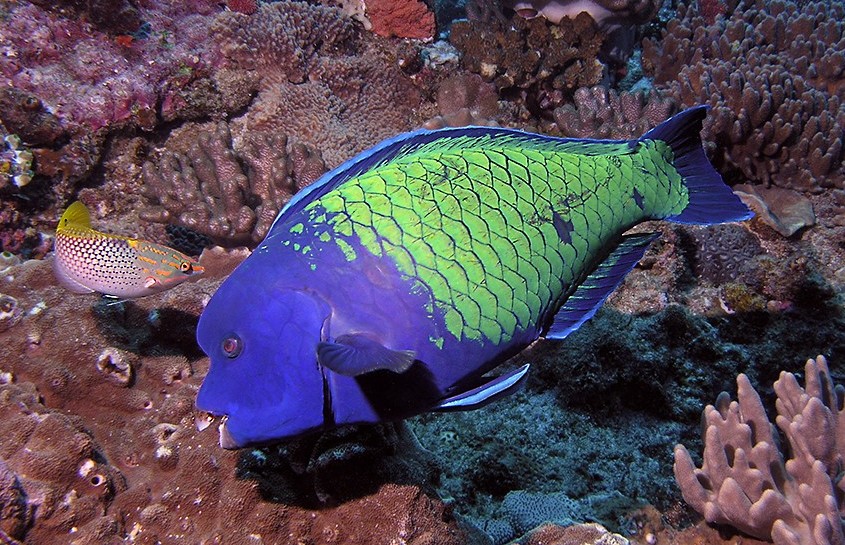Marine Life & Conservation
Diving the Indian Ocean Reefs

Parrot Fish… Did You Know?
The most colourful fish you’ll notice at on your first Indian Ocean dive may well be the spectacular turquoise-green, blue and pink male Ember Parrot Fish, (Scarus Riboviolaceus) which is by far the most common of the parrot fishes seen on our Indian Ocean reefs.

Male Ember Parrot fish
The males are gorgeous, and completely different from the juveniles and females.
Parrot fishes start life in the hard stag-horn corals and branching finger corals as insignificant little striped fish. The juvenile and semi-juvenile just look like any other small striped fish, with only the distinctive beak-like mouth to distinguish them from any other very young fish species.

Semi-Juvenile Ember Parrot Fish
They grow into nondescript rust grey and brown females who inconspicuously cruise across the reef crunching on the hard corals. As young fish they travel in groups, but as they get older and bigger, they feed alone.

Juvenile Ember Parrot Fish
As they grow their colouring develops, and they become more spectacular, with bigger bodies, richer fin outlines and the drab brown begins to bloom with new colour. There can only be one male in any area. One day, when the dominant male in an area dies, the largest female loses her mind and her drab colouring and turns into a peacock-coloured randy male who chases the drab brown females across the reef, mating indiscriminately.
As the male reaches terminal stage, his colouring begins to fade and he dies. We have seen huge terminal male Ember Parrot Fish in the sea-grass beds South of Stringer Reef at Sodwana Bay.

On the shallower reefs, you may be lucky enough to see the rare and beautiful Bridle Parrot (Scarus Frenatus) fish, and if you look carefully at the markings, you may be able to distinguish a Tricolour Parrot ( Scarus Tricolor) fish from a Christmas or Starry-Eyed (Calotomus carolinus) parrot fish, or spot an occasional Blue Moon Parrot ( Chlorurus Atrirunula) fish.

We have seen Blue Barred Parrot ( Scarus Ghobban) fish, and in deeper water, around and occasionally on the staghorn corals on the edge of 2 Mile Sodwana Bay, you might be lucky enough to see the richly coloured dark blue velvet of a female Hump Head Parrot ( Chlorurus Cyanascens) fish, or the ornate green and blue of the male Hump Head.

The Parrot fish family lives on the polyps and algae that make up the hard corals, and they graze continually. Living on hard corals is enormously time consuming, as the nutritious part of the polyp is minute. The parrot fishes are at least partly responsible for containing the growth of finger corals and branching corals.
They excrete a fine white powder which in part makes up most of the world’s powder white coral sand beaches – bio-sand production perhaps?
In Mauritius parrot fish are a delicacy, and the result has been a massive depletion in the variety of species near the main Island.
Under-age sex is the norm among the parrot fish here, with very juvenile females taking on the male role when they are too young. They are breeding a dwarf ember parrot fish, which has become quite prolific as it is too small to eat. I have often seen 8 inch little ember males haring after distinctly under-age females with lustful eyes.
On the outer Islands, the parrot fishes grow to normal size, as the subsistence fishermen cannot take their little boats out to the distant Islands. As the numbers of subsistence fishermen drops with the increase of wealth among the Mauritian population on the Island, perhaps we’ll see the exquisite parrot fish replaced on local menus by chicken.
[hr style=”single”]
Words Jill Holloway
Pics David Holloway
Copyright Ocean Spirit
Blogs
The Ocean Cleanup Breaks 10,000,000 KG Barrier

The Ocean Cleanup, the global non-profit project, has removed a verified all-time total of ten million kilograms (22 million lbs.) of trash from oceans and rivers around the world – approximately the same weight as the Eiffel Tower.
To complete its mission of ridding the oceans of plastic, The Ocean Cleanup uses a dual strategy: cleaning up the Great Pacific Garbage Patch (GPGP) to remove the plastic already afloat in the oceans, while stopping the flow of plastic from the world’s most polluting rivers.
Through cleaning operations in the GPGP and in rivers in eight countries, the cumulative total of trash removed has now surpassed ten million kilograms. This milestone demonstrates the acceleration of The Ocean Cleanup’s impact, while underlining the astonishing scale of the plastic pollution problem and the need for continued support and action.
While encouraging for the mission, this milestone is only a staging point: millions more tons of plastic still pollute our oceans and The Ocean Cleanup intends to continue learning, improving and innovating to solve this global catastrophe.
This announcement comes as governments from around the world meet to continue negotiations to develop a new legally binding instrument to end plastic pollution at INC4 in Ottawa, Canada. Representatives of The Ocean Cleanup will be in attendance and the organization will be urging decision-makers to collaborate towards a comprehensive and ambitious global treaty which addresses plastic at all stages of its life cycle and in all marine environments worldwide, including in areas beyond national jurisdiction.
It is encouraging to see that the need for remediation is reflected in the various options for potential treaty provisions. It is essential that the final treaty contains clear targets for the remediation of legacy plastic pollution, and reduction of riverine plastic emissions.
Tackling plastic pollution requires innovative and impactful solutions. The treaty should therefore incentivize the innovation ecosystem by fostering innovations that make maximal use of data, technology and scientific knowledge – such as those designed and deployed by The Ocean Cleanup.
‘After many tough years of trial and error, it’s amazing to see our work is starting to pay off – and I am proud of the team who has brought us to this point.’ said Boyan Slat, Founder and CEO of The Ocean Cleanup. ‘While we still have a long way to go, our recent successes fill us with renewed confidence that the oceans can be cleaned.’
The Ocean Cleanup was founded in 2013 and captured its first plastic in 2019, with the first confirmed catch in the GPGP coming soon after the deployment of Interceptor 001 in Jakarta, Indonesia. After surpassing one million kilograms of trash removed in early 2022, the non-profit project has since progressed to the third iteration of its GPGP cleaning solution, known as System 03, and a network of Interceptors currently covering rivers in eight countries, with more deployments set for 2024.
About The Ocean Cleanup
The Ocean Cleanup is an international non-profit organization that develops and scales technologies to rid the world’s oceans of plastic. They aim to achieve this goal through a dual strategy: stemming the inflow via rivers and cleaning up the legacy plastic that has already accumulated in the ocean. For the latter, The Ocean Cleanup develops large-scale systems to efficiently concentrate the plastic for periodic removal. This plastic is tracked and traced through DNV’s chain of custody model to certify claims of origin when recycling it into new products. To curb the tide via rivers, The Ocean Cleanup has developed Interceptor™ solutions to halt and extract riverine plastic before it reaches the ocean. Founded in 2013 by Boyan Slat, The Ocean Cleanup now employs a broadly multi-disciplined team of approximately 140. The foundation is headquartered in Rotterdam, the Netherlands.
For more information, visit: theoceancleanup.com and follow @theoceancleanup on social media.
Marine Life & Conservation
Steve Backshall to headline Shark Trust’s flagship event: For the Love of Sharks

Join a host of amazing, shark loving, speakers including Steve Backshall and the Shark Trust team for an evening celebrating shark conservation at the Royal Geographical Society in London this November.
Date: 29th November 2024
Time: 6-10pm
Location: Royal Geographical Society, London
Tickets: https://www.sharktrust.org/Event/flos24
The event will be a celebration of all things shark. Those lucky enough to get hold of tickets will hear from engaging guest speakers with a passion for sharks.
The line-up includes (*subject to change if unforeseen circumstances arise)
Steve Backshall: One of television’s busiest presenters, BAFTA award-winning wildlife expert Steve has been passionate about the wild world ever since he was young.
Steve’s impressive TV career has taken him all around the world, investigating a wide array of species and environments. Steve has filmed over 100 hours of children’s wildlife programmes with the BAFTA award winning Deadly 60 franchise and recently, with Sky Nature, for his new series ‘Whale with Steve Backshall’. He has been a patron for the Shark Trust for 10 years.
Simon Rogerson: is a photojournalist specialising in natural history, diving and the sea.
He is editor of SCUBA magazine, the official journal of the British Sub-Aqua Club. Simon started his career as a crime reporter but gravitated towards his ‘less depressing’ interest in underwater exploration, joining the staff of DIVE magazine in 1999. In 2005 he was named ‘Editor of the Year’ in the PPA’s Independent Publishing Awards. Simon also works as a freelance writer, contributing frequently to the Sunday Times and Telegraph, in addition to BBC Wildlife, Esquire, and a host of international diving magazines. He is the author of a book, Dive Red Sea, published by Ultimate Sports. Now based in Berkshire, Simon has been a Patron of the Shark Trust for 20 years.
More speakers to be announced soon. Head to the Shark Trust website to learn more.
The evening will also allow guests the final chance to see the Oceanic 31, shark art exhibition. Some of the artwork will be auctioned/raffled at the event, while the rest will be auctioned online to raise money for the Shark Trust Oceanic Programme.
For the Love of Sharks is an evening with something for everyone who is interested and fascinated by sharks. Join the Shark Trust, their Patrons, Trustees and Staff, along with a host of supporters for this celebration of shark conservation.
For more information or to buy a ticket: https://www.sharktrust.org/Event/flos24
-

 News3 months ago
News3 months agoCapturing Critters in Lembeh Underwater Photography Workshop 2024: Event Roundup
-

 Marine Life & Conservation Blogs3 months ago
Marine Life & Conservation Blogs3 months agoCreature Feature: Swell Sharks
-

 Blogs2 months ago
Blogs2 months agoMurex Resorts: Passport to Paradise!
-

 Blogs2 months ago
Blogs2 months agoDiver Discovering Whale Skeletons Beneath Ice Judged World’s Best Underwater Photograph
-

 Gear Reviews3 weeks ago
Gear Reviews3 weeks agoGEAR REVIEW – Revolutionising Diving Comfort: The Sharkskin T2 Chillproof Suit
-

 Gear Reviews3 months ago
Gear Reviews3 months agoGear Review: Oceanic+ Dive Housing for iPhone
-

 Marine Life & Conservation2 months ago
Marine Life & Conservation2 months agoSave the Manatee Club launches brand new webcams at Silver Springs State Park, Florida
-

 News2 months ago
News2 months agoPADI Teams Up with Wellness Brand Neuro to Drive Ocean Change and Create a Blue State of Mind





